What is Tooth decay or Cavities?
Tooth decay or dental caries is an irreversibly damaged tooth surface that further develops into holes or cavities. Dental cavity is caused by multiple factors are various bacteria, sweetening agents, carbohydrate food, plaque formation, etc.
Dental caries is a most common dental disease which affects almost all age groups of people including teenagers, infants, and old age people.
If we don’t pay attention or are left untreated, it gets harder and rapidly involves the inner structure of the tooth which can lead to severe toothache and infection like pus which further converts into a cystic lesion.
Sign and Symptoms
- Tooth pain
- Tooth Sensitivity
- White or black, brown spot on the tooth surface
- Cavity or hole on the tooth surface
- Swelling
- Pain while chewing
- Bad breath (halitosis)
All these are signs and symptoms of cavities that you notice and feel if you have cavities.
What do cavities look like?

Dental X-ray looks, black and white structures. White structures seen as radiopaque represent solid structures, while black structures seen as radiolucent represent hollow structures. A dental cavity is not a solid structure, as defined it is a hole or cavity in the tooth surface, so it shows a black radiolucent area or spot within white radiopaque areas.

Causes and stages of Tooth decay
Causes of Cavities
1. Sweetening agents : Certain food particles are left on the tooth surface for a long time such as milk, soda, sugar substitute, and chocolate, which is not easily washed by saliva. It will lead to tooth decay over a period of time.
2. Position of tooth :
Tooth position is the most common causing factor for dental caries. Rotated or Overlap teeth are difficult to clean.
The most common teeth for decay are molars and premolars because it has multiple pits and grooves, and multiple roots that can collect food particles easily, as a result, difficult to clean this area compare to other teeth.
Dental plaque is a film-like substance that coated the tooth surface, it contains mainly bacteria. If dental plaque is left untreated it gets harder, converts into calculus (tartar), which is difficult to remove and leads to tooth decay.
3. Dental plaque :
Dental plaque is film like substance that coated tooth surfaces, it contains mainly bacteria. If dental plaque is left untreated it gets harder, converts into calculus (tartar), which is difficult to remove and leads to tooth decay.
4. Xerostomia ( Dry mouth ) : Xerostomia or dry mouth means lack of saliva. Due to decreased saliva food substance or plaque can’t be washed off by saliva eventually it leads to tooth decay.
5. Improper brushing : If we don’t maintain hygiene or don’t brush or clean our teeth after eating or drinking, plaque formation can occur and it leads to dental caries.
Process or Stages of Tooth decay
When the tooth is exposed to carbonated drink or acid more frequently so the tooth will get demineralized and forms a cavity.

First, when only the enamel (first layer of the tooth) gets demineralized, at this stage white spot is present on the enamel, if oral hygiene maintains properly and fluoride application works, saliva can remineralize enamel and reverse the tooth damage.
If decayed goes to the dentin (second layer of the tooth), sensitivity and pain are felt by patients. The cavity becomes larger at this stage ultimately we need to go through a large cavity filling or Dental Crown.
If decayed involves pulp tissue (third layer of the tooth) and sharp shooting pain felt by the patient, we need to go under the root canal treatment. If left untreated, the infection involves the periapical area (root end area) and forms the periapical abscess lesion. At this stage, the patient feels mobility in that tooth, severe pain, and extraoral swelling are also present. Ultimately, removal of the tooth is the only option left.
Treatment and Prevention
How to get rid of cavities?
If decay or cavities is in the initial stage or extend up to enamel or dentin (second layer of the tooth). We can go with stage 1 treatment which is known as Dental filling or Restoration. If decay involves the third layer of the tooth (dental pulp), we need to go for root canal treatment.
If we delayed the treatment, lead to a periapical abscess, swelling of gums, and swelling of the face related to the tooth region, ultimately option will be removal and replacement of the tooth.
Dental filling or Restoration :
There are various types of filling eg.,
- Silver filling
- Cast gold filling
- Glass ionomer filling
- Composite Resin filling
Which dental filling material is suited for my tooth decay?
Don’t worry! It will be suggested by your dentist will recommend you, based on your tooth decay, the extent of cavities, and the location of the tooth.
Procedure of Dental filling :
The dental filling is a minimally invasive dental treatment. It will take a single appointment and require 25-30 min time.
Step 1 : The dentist will remove your decayed or cavitated portion of the tooth with the airroter (drill machine). After that, it will check with instruments for any leftover dental caries and prepare a cavity for filling material.
Step 2 : Place a rubber dam to cover unexposed teeth and exposed affected teeth.
Step 3 : Dry the cavity, maintain isolation, and placed the filling material into the cavity.
If required application of liner or base before restoration.
Step 4 : Check the occlusion, and remove high points if any.
How to prevent Cavities?
1. Proper use of Brushing : Brushing twice a day with fluoridated toothpaste can decrease the chances of tooth decay. A toothbrush should be changed every 2 months, if possible we should use a toothbrush with ultra-soft bristles, it will prevent long-term damage to the tooth.
2. Sugar intake : Avoid or reduce taking sugar substitutes most frequently or try to consume between meals. Prevent the long-term exposure of food particles mostly sweetening agents on the tooth surface, it will lead to plaque formation and ultimately it will lead to tooth decay.
3. Oral hygiene : Maintain oral hygiene properly after taking sugar substitutes or acid contains food. You should use dental floss or interdental brush and mouthwash if required. We can use the Warer flosser, it is useful, especially in those areas where brushing is difficult and most posterior areas of the oral cavity. You should floss first before brushing your teeth.
4. Regular dental check-up: Visit the dentist every six months, so if there is decay or the initiation of cavities we can prevent them. Also, every year regular dental check-up helps to increase your tooth health. Tooth health is directly connected to overall health, so ultimately your overall health will be good.
5. Fluoride application : There are many ways to fluoride treatment. We can brush with fluoridated toothpaste twice a day, and use fluoridated mouth rinse twice in a week. In children, we can give fluoride treatment in periodic intervals such as 6 months or 12 months to prevent tooth decay.
6. Pit and fissure Sealants : Pit and fissure are protective coatings applied on the occlusal surface of a tooth (top surface, used while chewing) from preventing tooth decay. Pit and fissure sealants form a hard shield on a tooth, so tiny food particles and bacteria cannot penetrate into deep grooves and fissures. Pit and fissure sealants are mostly used in the posterior tooth due to its anatomy, they have larger grooves and fissures.
Pit and fissure sealants are smooth, act as a protective barrier against deep grooves and sealed the fissures, and prevent further tooth decay. Pit and fissure sealants are usually done between the age of 6-7 yrs when the first permanent tooth erupts into the oral cavity.
The process of pit and fissure sealants is taking hardly 10 mins for a tooth. The tooth is prepared for sealants, dried on the tooth surface, the liquid sealant is applied, and allowed to set hard or cure with curing light. It is a painless procedure, last for several years, but can wear after some time, so a routine dental checkup with your dentist is a must require.
Frequently asked questions
1. what is the difference between tooth cavities and stains?
A cavity is a permanently damaged tooth structure in the form of a small hole or cavity, caused by certain bacteria, plaque biofilms. it needs to be treated by dental professionals. Stains are discoloration of enamel, caused by certain food, acidic drink, and some habits. It can be both intrinsic and extrinsic.
Causes of cavity :
- Dry mouth / Xerostomia
- Poor oral hygiene
- Certain diseases
- Lack of fluoride
- Taking too much sugar-content food
- Lack of fluoride
Causes of stains :
- Smoking
- Tea/coffee
- Tobacco
- Alcohol
- Carbonated drink
- Excessive fluoride
- Certain medications
2. Is Tooth decay Contagious or not?
Basically, decay on the tooth occurs due to bacteria, plaque, and sugar substitutes and it mostly afftects young childrens. Mostly bacteria which cause cavity can also transmitted by saliva that means cavities are contagious.
3. Are black spots also dental caries?
Yes, sometimes. If there is no hollow structure or holes in the tooth it may be discoloration due to fluorosis, some antibiotics, medications in children, etc. But if there is a hole or you felt sensitivity or pain, it is tooth decay. You should visit your dentist regarding the same.

